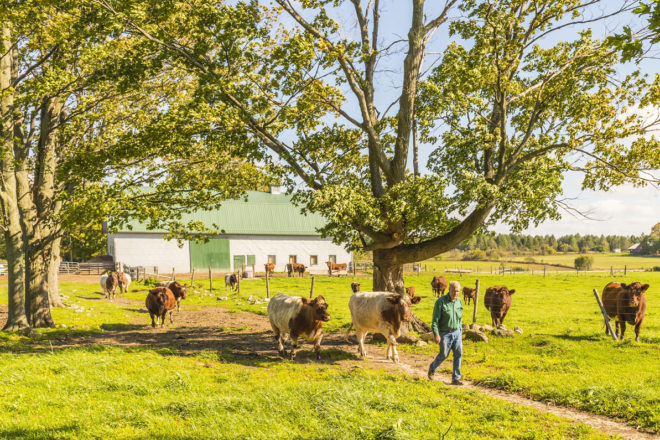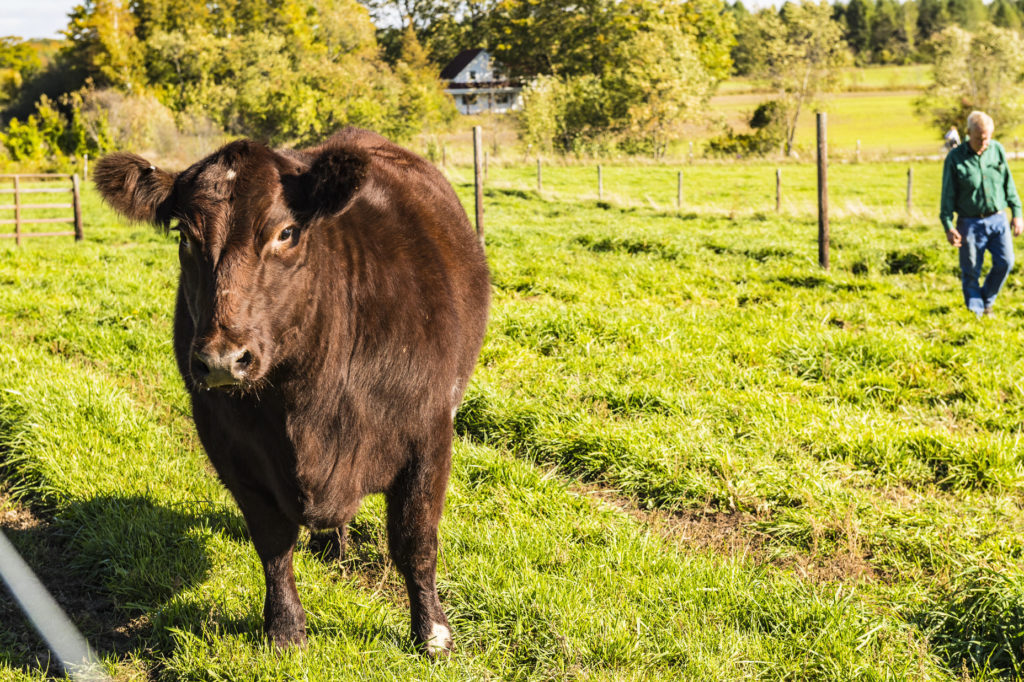A Farmer and His Cattle: Raising Shorthorns on Washington Island
- Share
- Tweet
- Pin
- Share

Every morning for the past year, Joe Elmore has risen with the sun, its rays bouncing off the waters of Washington Harbor and into his home on the northern end of Washington Island. He makes his way down the road to a barn at Riola Shorthorn Farm. Inside the barn, fans are blowing cool air on his most prized Shorthorn cattle and the barn keeps the morning sun out. That’s how they grow their winter hair, Elmore explained.
It’s almost show time.
Cattle shows have a storied history in Wisconsin’s agricultural past and Shorthorns have something of a cult following.
“The Shorthorn has had, in my opinion, a bad rap,” said Elmore from his deck overlooking Washington Harbor on a sunny July day, a month before he takes his Shorthorns on tour throughout the Midwest. He has washed up from his morning work with the cattle, but a farmer’s dirt still clings to his fingertips.
“Everybody wants black cattle and that’s simply because of marketing,” he said. “But we go to Louisville at the largest show in the world and there’s more Shorthorns there than any other breed.”
Like any niche hobby, those who own Shorthorns gather at every opportunity to compete and share their work. Elmore’s cattle are regulars at the Door County Fair and both the Wisconsin and Illinois state fairs. Loading the cattle on a trailer and hauling them across Death’s Door heading south is a bit like going home for the Illinois native.
“We always had cattle in Illinois,” said Elmore, a third generation Shorthorn hobbyist. “We were the village idiot down there for having cattle because it’s all flat, black farmland, but you have to do what you enjoy.”
Elmore would visit his in-laws on Washington Island with his wife, Linda, while farming in south-central Illinois. The couple knew when the time came to retire from farming, the island at the end of the Door Peninsula is where they wanted to be.
A melanoma diagnosis brought that day a little closer than the two anticipated.
“The doctor initially said a year max,” Elmore said, recalling the diagnosis 12 years ago. “It just encouraged me to come up here quicker than I originally planned.”
Purchasing the farm and relocating his Illinois cattle up to the island was a way to keep busy after the first year of his diagnosis passed, the melanoma not to return. Since then, Elmore has been involved in the local 4-H group, introducing the younger generation to the cattle show.
“The Shorthorn breed has evolved where, as a rule, they’re very gentle,” Elmore said. “Every animal has a different personality — it’s like humans.”
Elmore spoke about the Shorthorn’s meat marbling, or how the fat is dispersed through the meat, saying it’s tastier than the finest Angus beef. The primarily pure-bred Shorthorns can also serve as both dairy and beef cattle, although there are only a few commercial Shorthorn farmers in the country.
 Instead, the animal does most of its work in the rings of regional fairs. Preparing the cattle for those fairs is what Elmore spends four hours each morning doing in his cold, dark barn.
Instead, the animal does most of its work in the rings of regional fairs. Preparing the cattle for those fairs is what Elmore spends four hours each morning doing in his cold, dark barn.
“We rinse them then we comb their hair with a big blow dryer,” Elmore said, describing his morning routine. “Then they sit under fans in the dark all day because what we’re trying to do is to fool them that the days are getting shorter so they grow their winter hair.”
By simulating the approach of winter, the cattle’s hair gets longer and thicker, making it easier to mold when it’s time to compete at a show.
“You can cover up a lot of imperfections with hair,” Elmore said. “You want it fluffed up so it makes them look bigger.”
Before the show, Elmore uses glue to sculpt the cow’s hair. The animal circles around the edge of the ring while the judge stands in the middle, looking for a straight top, good girth, steady legs and a depth of body. Elmore flips through his latest issue of Shorthorn Country magazine, adding “general eye appeal” to the list of qualities.
For those who know little about cattle, being told about general eye appeal is a bit like standing in a forest with a lifelong biologist; their eyes scanning every detail with fascination while you stand there dumbly, barely able to describe what you see.
But for the initiated, it is a world of competition and camaraderie glued together by an animal most people don’t think twice about.
“You have to have vices and this was my vice,” Elmore said. “Some people drink, some people golf.”
Elmore has cattle, at least for a little while longer.
“My comment last year after doing this whole thing was that I’d never do it again and then here I am,” Elmore said. “This year I took on too many [shows] but in every one of them there was a purpose.”
 Elmore may be the end of the line for his family’s involvement in Shorthorns. While one of his sons still farms grain on the family land back in Illinois, he has no interest taking back his dad’s cattle. The other is an internationally touring musician with a heavy metal band whose name, Cattle Decapitation, is about as close as he will get to raising Shorthorns.
Elmore may be the end of the line for his family’s involvement in Shorthorns. While one of his sons still farms grain on the family land back in Illinois, he has no interest taking back his dad’s cattle. The other is an internationally touring musician with a heavy metal band whose name, Cattle Decapitation, is about as close as he will get to raising Shorthorns.
Elmore takes another sip of his iced tea and moves his chair further into the shade as the sun climbs higher over the island. Shorthorn Country rests on his lap, open to a page with pictures of prize-winning cattle at shows across the country. There is an edge of competitiveness in his voice but it’s tempered by a love for the hobby and the animal that has connected his father and grandfather with his own mortality of a 12-year-old diagnosis. It’s hard to imagine he is done.
“I don’t think I’ll ever show this many again,” Elmore said. “But I’m not willing to say.”
